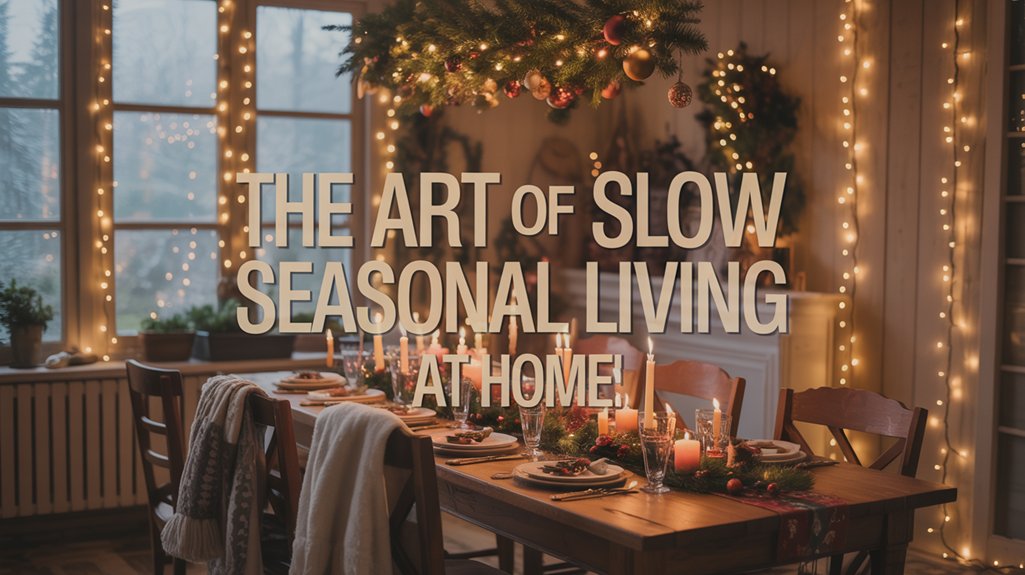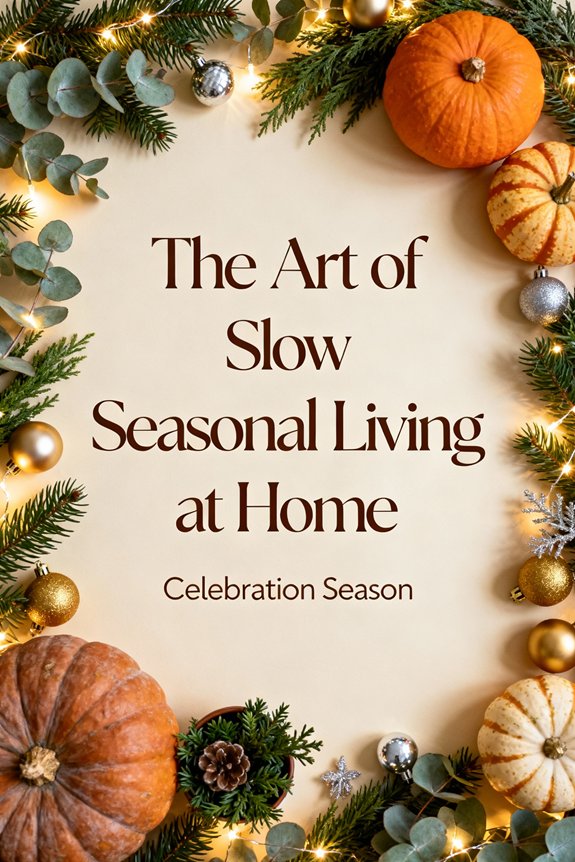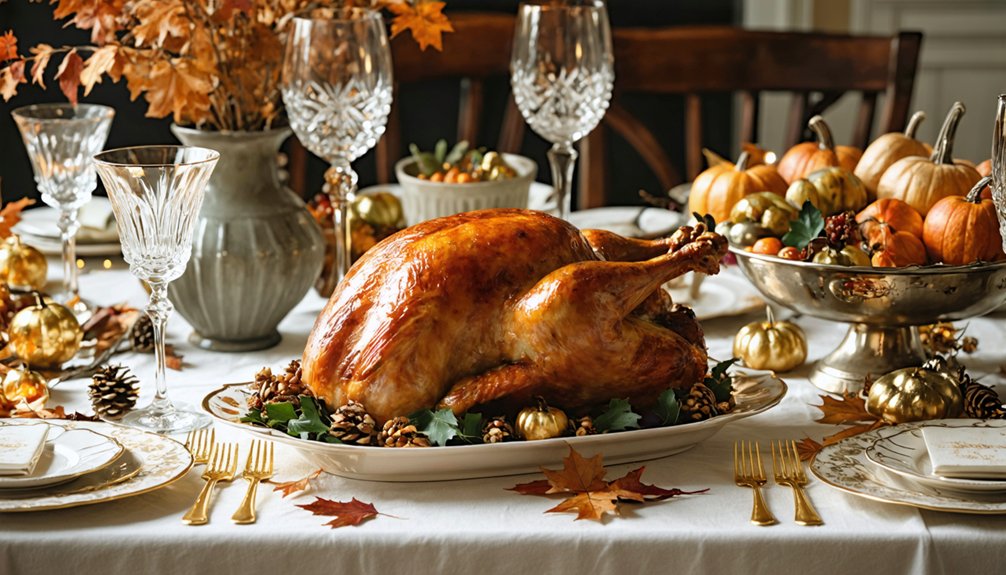Slow seasonal living means reconnecting with nature's rhythms by aligning your home and routines with the world outside your window. You'll swap your linens for rust-colored throws in autumn, dim lights as sunset approaches, and fill your space with foraged branches that serve as a living calendar. It's about eating tomatoes in July instead of January, honoring winter's call for rest, and creating simple rituals—like lighting candles or visiting farmers' markets—that anchor you to each season's unique invitation.
Key Takeaways
- Align daily routines with natural light by opening curtains at sunrise and dimming lights at sunset to reconnect with nature's rhythms.
- Refresh home decor seasonally with natural elements like foraged branches, pinecones, and wildflowers to create a living calendar of change.
- Use seasonal scents like lavender in spring, cinnamon in fall, or pine in winter to enhance mindfulness and evoke memories.
- Eat locally grown seasonal produce from farmers' markets to enjoy better flavor, nutrition, and stronger community connections.
- Create simple seasonal rituals like lighting candles, baking, or morning tea ceremonies to anchor yourself to nature's rhythm.
Understanding the Rhythms of Nature in Your Daily Life
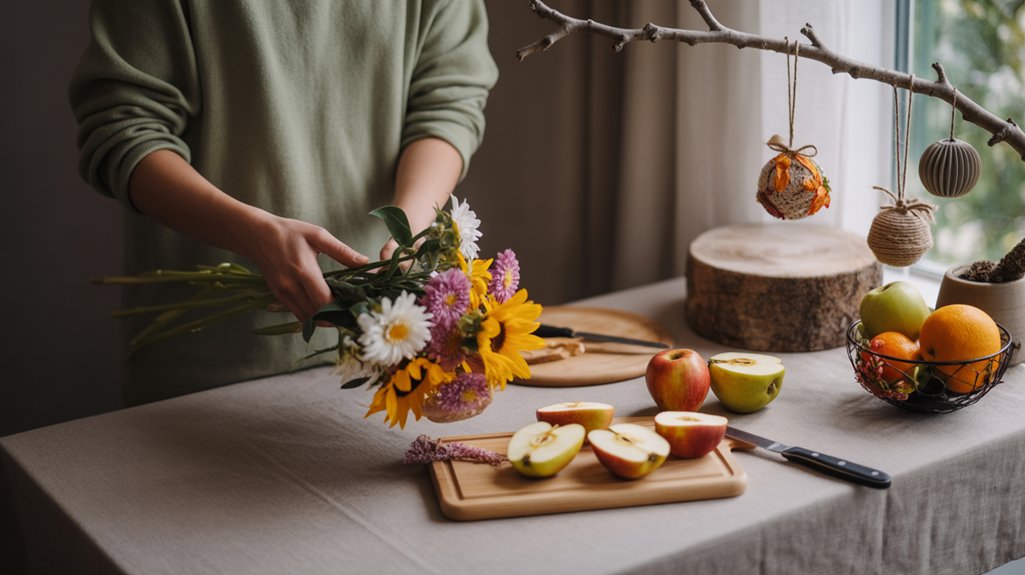
When you start paying attention to the world outside your window, you'll notice patterns you've probably overlooked for years. The earlier sunsets in autumn, the first robin's arrival each spring, the way morning light shifts across your kitchen table—these aren't random occurrences.
They're nature's cycles speaking a language we've forgotten how to hear.
I remember the morning I realized my grandmother always planted tomatoes when lilacs bloomed. She wasn't following a calendar; she was reading the earth's cues.
Mindful awareness of these rhythms alters how you move through your days. You'll find yourself adjusting bedtimes with daylight, craving root vegetables when temperatures drop, and feeling energized during spring's lengthening days.
This isn't about perfection—it's about reconnection. You're joining a community of people who've chosen to live in conversation with the seasons rather than in spite of them. As you prepare for festive gatherings throughout the year, these natural rhythms can guide your celebrations and make them feel more authentic and grounded.
Creating a Seasonal Home Environment Through Simple Shifts
You don't need a complete home overhaul to honor the shifting seasons—I've found that swapping a few key elements creates an entirely different atmosphere in my space.
When autumn arrives, I replace summer's gauzy whites with rust-colored linens, light a cinnamon candle, and set a bowl of pinecones on the dining table.
These small, intentional changes help me feel anchored to the present moment and attuned to what's happening just outside my window.
Whether you're preparing for holiday celebrations or simply marking the passage of time, these seasonal shifts transform your home into a reflection of nature's rhythm.
Natural Light and Textiles
As daylight shifts with the seasons, your home naturally calls for different textures and fabrics that respond to the changing quality of light streaming through your windows.
I've learned that natural light alters how textile textures appear—what feels cozy in winter's dim glow can overwhelm in summer's brightness.
Consider these seasonal swaps:
- Spring/Summer: Replace heavy velvet cushions with lightweight linen throws that catch and diffuse abundant sunlight.
- Autumn: Layer wool blankets in warm tones that glow as golden hour lengthens across your floors.
- Winter: Embrace chunky knits and darker fabrics that absorb scarce daylight, creating intimate spaces.
- Year-round: Keep sheer curtains to filter harsh rays while maintaining connection to the outdoors.
You're creating a home that breathes with nature's rhythms.
Scent and Seasonal Elements
While your eyes adapt to shifting light and textures throughout the year, your nose holds equally powerful memories of seasonal change. You'll find that scented candles become anchors for mindful shifts—lighting one signals you're honoring the moment.
Consider building your fragrance wardrobe intentionally:
| Season | Signature Scents |
|---|---|
| Spring/Summer | Citrus, lavender, fresh-cut grass |
| Fall/Winter | Cinnamon, pine, woodsmoke |
| Year-Round | Vanilla, eucalyptus, clean linen |
I've learned that seasonal fragrances needn't be complex. A single sprig of rosemary from your garden carries December better than any manufactured blend. You're not performing seasons—you're experiencing them. Let scent remind you where you are in the year's gentle rhythm, creating belonging within time itself.
Eating With the Seasons: a Return to Intuitive Nourishment
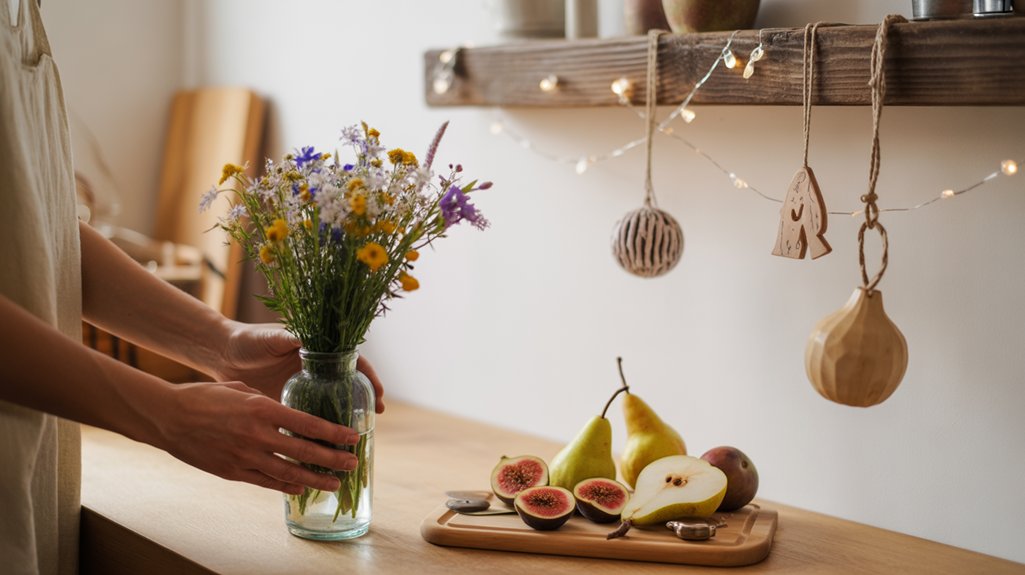
You'll notice something shift when you start eating strawberries only in June and butternut squash when autumn arrives—suddenly, food tastes like something again.
I remember the first time I bit into a sun-warmed tomato from the farmers market in August after avoiding the pale winter ones; it was like tasting tomato for the first time.
When you align your meals with what's naturally growing around you, you're not just nourishing your body differently—you’re reconnecting with an ancient rhythm that your great-grandmother would've found completely ordinary.
Benefits of Seasonal Eating
When you bite into a sun-warmed tomato in August or savor the first crisp apple of October, you're experiencing something profound that no greenhouse-grown produce can replicate.
Seasonal eating offers remarkable rewards:
- Enhanced nutritional benefits – Peak-season produce contains higher vitamin and antioxidant levels
- Deeper community connection – Shopping farmers' markets creates relationships with growers who share your values
- Environmental harmony – Local seasonal foods require less transportation and storage
- Financial wisdom – Abundant harvests mean lower prices
I'll never forget my first autumn preserving tomatoes with neighbors, converting summer's bounty into winter comfort.
We've gathered every September since.
You're not just choosing better ingredients; you're joining a movement of mindful eaters who understand that patience and rhythm create both healthier bodies and meaningful bonds.
Finding Local Seasonal Produce
As you step into your local farmers' market on a Saturday morning, you'll notice something magical happens—the produce itself tells you what season you're in. Those ruby-red tomatoes in August, the crisp apples come October—they're nature's calendar, and you're learning to read it again.
I've found that farmers markets become more than shopping trips; they're weekly rituals where vendors remember your name and share recipe tips.
If weekly visits don't fit your schedule, community supported agriculture programs deliver seasonal boxes right to your door, connecting you directly with local growers.
These connections alter how you eat. You're not just buying vegetables—you're joining a network of people who value freshness, sustainability, and the simple pleasure of eating what's ripe now.
Simple Seasonal Recipe Ideas
Once you've brought home your seasonal bounty, the kitchen becomes your creative studio—and here's the beautiful part: seasonal cooking doesn't require complicated techniques or exotic ingredients.
When you work with fresh seasonal ingredients, simple preparations let their natural flavors shine.
Four Approaches to Seasonal Cooking:
- Roast root vegetables with olive oil and herbs—winter's earthy sweetness needs nothing more.
- Toss summer tomatoes with fresh basil and good salt for an instant celebration.
- Sauté spring greens in butter until they're just wilted and vibrant.
- Bake autumn squash until caramelized, then drizzle with maple syrup.
You're not following recipes—you're having a conversation with your food, letting each season guide your hands and nourish your table.
Adapting Your Daily Routines to Natural Light Cycles
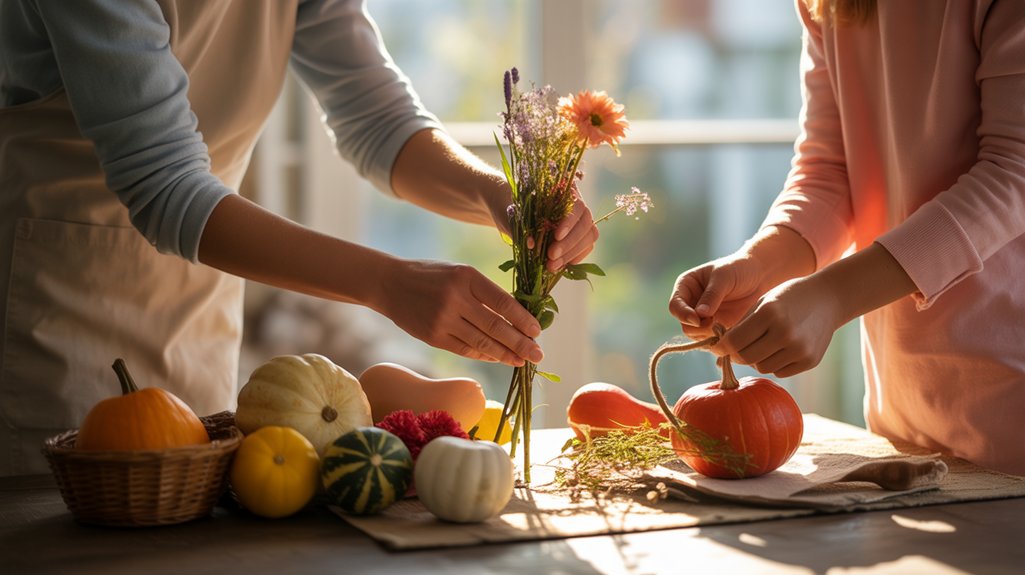
Though we've grown accustomed to artificial lighting that keeps our homes bright at any hour, there's something deeply grounding about letting daylight guide your rhythm again.
I started opening my curtains first thing each morning, letting sunrise dictate when I'd naturally wake. My coffee tastes different in dawn's soft glow—more intentional somehow.
Light adaptation isn't about rigidity; it's about noticing when your energy naturally peaks and dips throughout the day.
You'll find your daily rhythms shift with the seasons. Summer mornings might inspire early garden work, while winter afternoons become perfect for creative projects near windows. I've moved my desk three times this year, always chasing the best natural light.
Try dimming artificial lights an hour before sunset. Your body remembers this ancient pattern, even if your schedule doesn't always allow perfect alignment.
Small adjustments create profound connections to the world spinning outside your walls.
The Practice of Seasonal Decluttering and Letting Go
When autumn arrived last year, I noticed how naturally the trees released their leaves—no hesitation, no hoarding what had served its purpose.
This observation altered how I approach seasonal decluttering in my own home.
You can embrace this same rhythm by practicing mindful minimalism with each seasonal shift. Rather than aggressive purging, think of it as gentle release—honoring what you've used while making space for what's ahead.
Here's how to begin:
- Assess one category per season (winter clothes in spring, summer gear in fall)
- Ask if each item still serves your current season of life, not just the calendar
- Acknowledge emotional attachment without letting it control decisions
- Pass items to others who'll genuinely use them, creating connection through giving
This practice isn't about achieving minimalist perfection. It's about creating breathing room in your spaces and recognizing that letting go makes room for growth.
Bringing Nature Indoors: Foraged Decor and Seasonal Elements
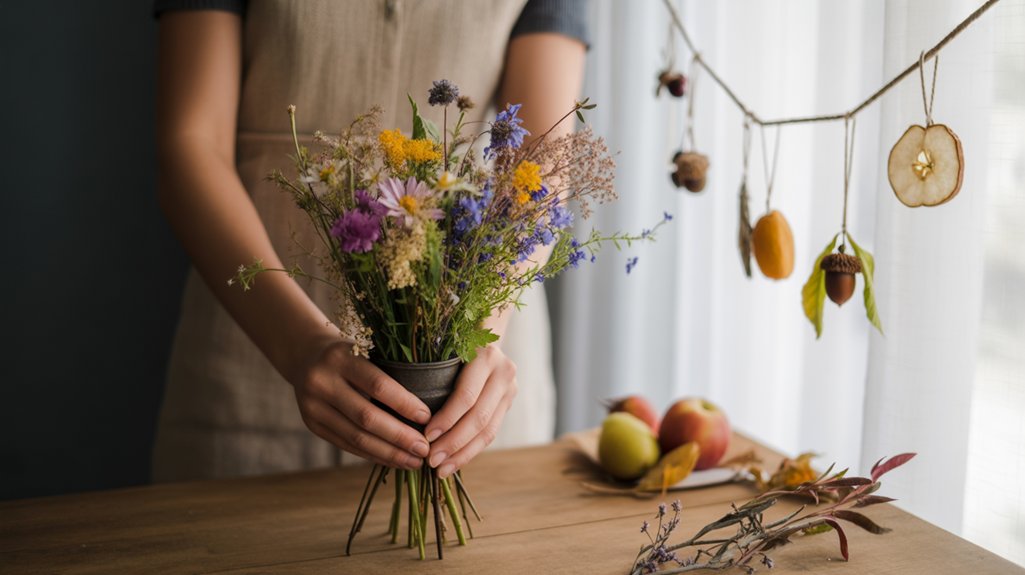
As you create space through seasonal decluttering, you'll naturally want to fill those cleared surfaces and corners with something meaningful. This is where foraged materials become your creative allies—bringing the outside world into your home without spending a dime.
I've found my best nature inspired accents during weekend walks: smooth river stones in spring, wildflower bundles in summer, branches of turning leaves in autumn, and pine boughs in winter. These treasures cost nothing but attention.
Display them simply. A single branch in a vintage bottle speaks volumes. Acorns scattered on a windowsill mark autumn's arrival. Pussy willows announce spring's return.
You're not just decorating; you're marking time's passage and deepening your connection to place. Each foraged piece tells a story about where you've been and what you've noticed.
Your home becomes a living calendar, shifting with the seasons rather than against them.
Honoring Rest and Activity Through the Year's Quarters
Just as nature cycles between growth and dormancy, our bodies crave different rhythms throughout the year.
You'll find that honoring these natural ebbs and flows creates a more sustainable life at home.
Consider aligning your lifestyle with each season's inherent energy:
- Winter invites restful practices—think afternoon tea rituals, early bedtimes, and creative projects by the fire.
- Spring awakens active pursuits like morning walks, garden planning, and deep cleaning that actually feels energizing.
- Summer encourages outdoor gatherings, sunrise yoga, and preserving the harvest while daylight stretches long.
- Autumn balances both—vigorous hikes paired with cozy reading nooks and reflective journaling.
I've noticed my energy naturally peaks in spring and summer, while winter begs for stillness.
There's profound relief in accepting this rather than fighting it.
You're not lazy for resting deeply in February or overcommitted for socializing more in June—you're simply attuned to what's real.
Building Meaningful Rituals That Mark Seasonal Transitions
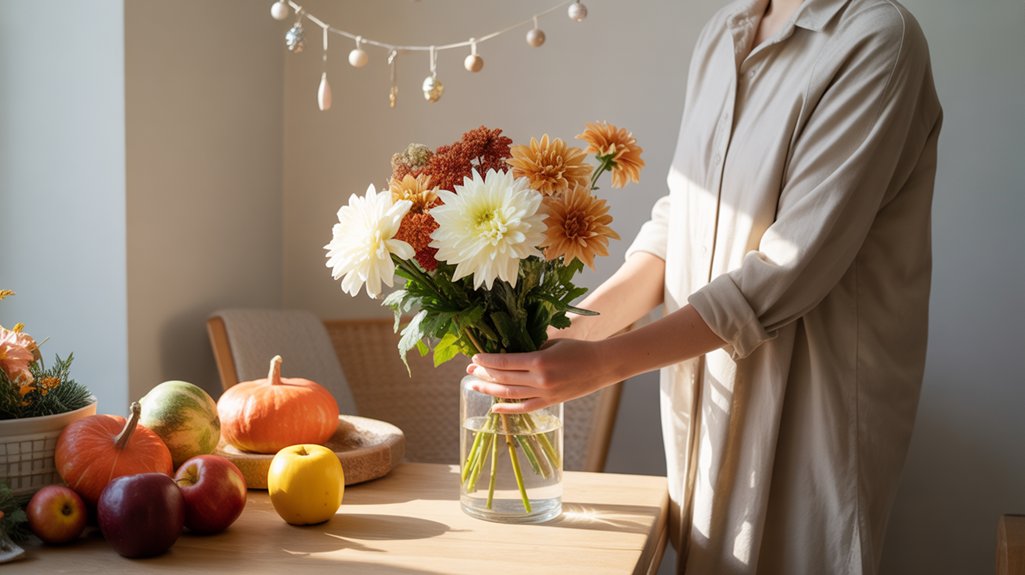
Because our modern lives blur one day into the next, we've lost something precious: the sense that time itself has texture and meaning.
You can reclaim this by creating seasonal traditions that anchor you to nature's rhythm. I light my first autumn candle on the equinox, filling my kitchen with cinnamon while baking apple bread. It's simple, but it signals the change.
Your rituals don't need Instagram-worthy production. They need resonance. Perhaps you'll gather fallen leaves for your table's centerpiece, or swap your bedding as temperatures change. These mindful celebrations alter ordinary moments into markers of shift.
The beauty lies in repetition. When you perform the same ritual each season, you're building a personal heritage. You're telling yourself: I'm paying attention. I'm present. You're joining countless others who've honored earth's cycles, creating belonging across time itself.
Start small. Choose one change. Make it yours.
Frequently Asked Questions
How Do I Practice Slow Seasonal Living in a Small Apartment?
You don't need sprawling spaces to embrace seasonal rhythms—your small apartment becomes a sanctuary through intentional apartment decor and mindful routines.
I converted my tiny studio by swapping throw pillows each season and brewing morning tea while watching sunrise colors shift.
You'll discover that opening windows to spring breezes or lighting autumn candles creates profound connections to nature's cycles.
Start small: one seasonal corner, one daily ritual. You're already home; now make it seasonally yours.
Can I Combine Seasonal Living With a Busy Work Schedule?
You can absolutely weave seasonal living into your packed calendar—it's like adding spices to a familiar recipe.
I've discovered that seasonal mindfulness doesn't require hours; it's about micro-moments. You might sip pumpkin tea during morning emails or light a pine-scented candle while answering calls.
These tiny rituals create work life balance without overhauling your routine. You're joining countless others who've learned that slow living adapts to real life, not the other way around.
What if I Live in a Climate Without Distinct Seasons?
You'll discover seasonal mindfulness through subtle shifts—monsoon rains, temperature changes, or migration patterns.
I've watched friends in tropical climates celebrate mango season like I celebrate spring blooms.
Your climate adaptation becomes uniquely yours: perhaps you'll honor the wet and dry seasons, or mark celestial events.
You're not missing out; you're creating rhythms that honor your specific place.
That's the beauty—seasonal living adapts to wherever you call home.
How Much Does It Cost to Start Living Seasonally?
Absolutely nothing—or as much as you'd like.
I started with a single pumpkin from the farmer's market and called it “budgeting for seasons.”
You're already buying groceries, so seasonal meal planning just means choosing what's naturally abundant (and cheaper!).
Swap tulips for apples in fall, notice the light changing through your windows.
The most meaningful shifts happen when you simply pause and attune to what's already around you.
Your seasonal life begins with awareness, not a shopping cart.
Is Slow Seasonal Living Compatible With Modern Technology Use?
You'll find that slow seasonal living actually improves your relationship with technology through digital mindfulness.
I've discovered that checking weather apps becomes intentional ritual rather than mindless scrolling.
You're creating tech balance by using devices purposefully—photographing autumn leaves, researching seasonal recipes, connecting with like-minded souls online.
It's not about rejection; it's about integration.
Your phone becomes a tool for deepening seasonal awareness, not escaping it.
We're redefining what modern living means together.
Conclusion
You'll discover that slow seasonal living isn't about perfection—it's about presence. I've found my most peaceful mornings happen when I'm simply noticing the angle of sunlight shifting across my kitchen table. What if tuning into nature's rhythm is the permission you've been waiting for to slow down? Start small: light a candle at dusk, place autumn leaves on your windowsill, breathe deeply. You're already enough, exactly where you are.

